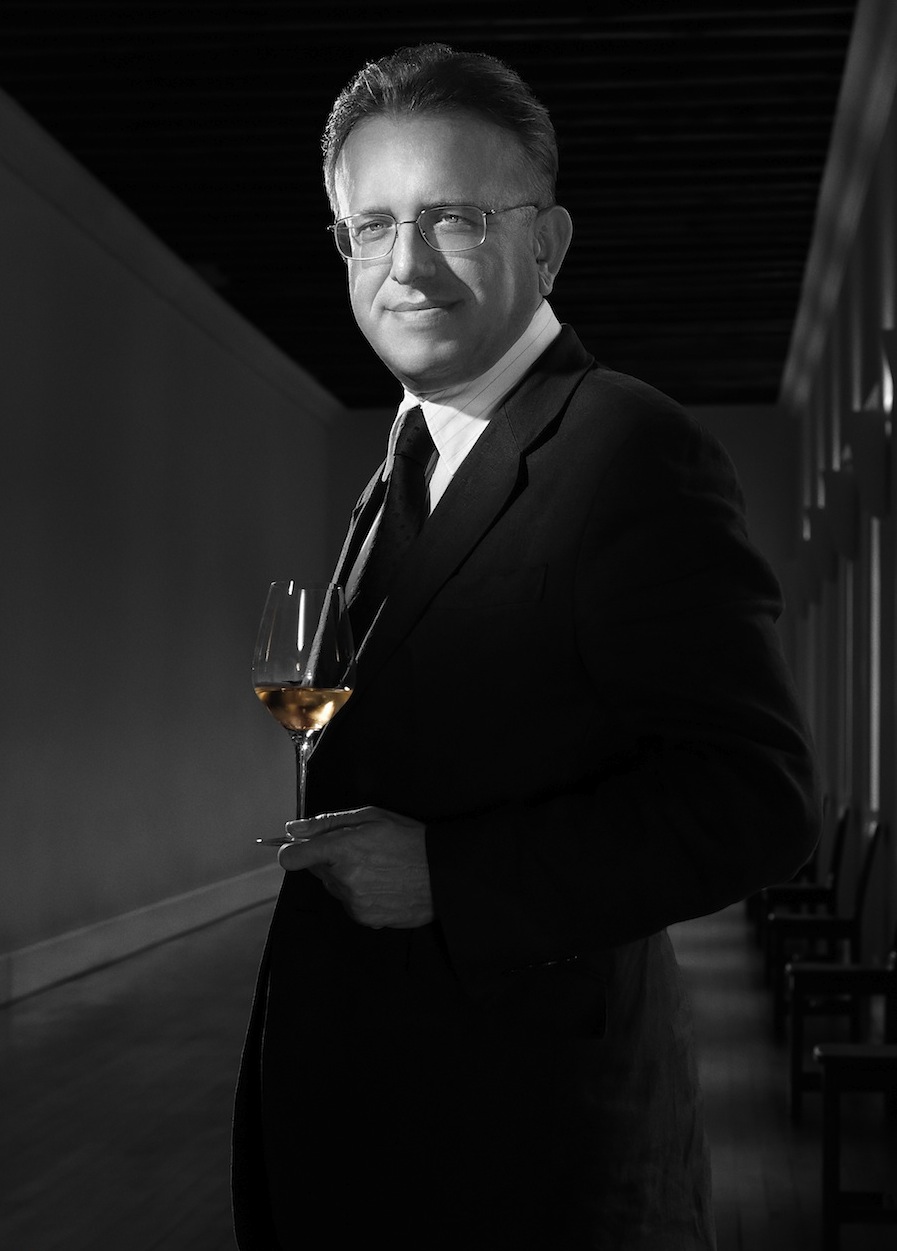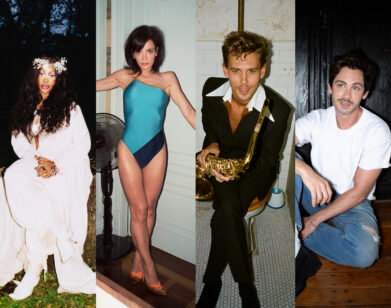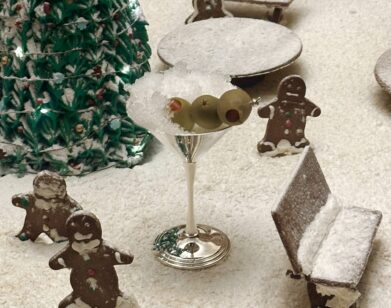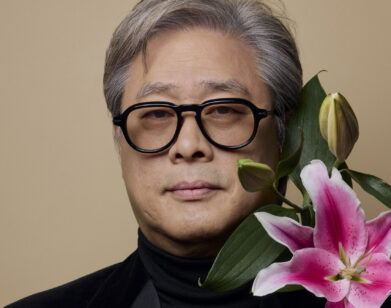Tasting Stars with Dom Pérignon’s Richard Geoffroy
When Dom Pérignon Rosé 2002 was introduced in the UK three weeks ago, it sold out before noon. For one store, that would be impressive. DP Rosé 2002 sold out in the entire country.
Sampling the Champagne with Dom Pérignon’s chef de cave, Richard Geoffroy, in the Greenwich Hotel earlier this week to celebrate the vintage’s Stateside launch, it was obvious why. Even if, like us, you’re a relative wine novice, it’s impossible to sip a glass of the Rosé 2002 without realizing you’re drinking among the best Champagne you’ll ever taste. It is complex, saturated with layers of flavor, perfectly bubbly, and pleasantly intense. It is also, it’s worth noting, only the second rosé champagne deemed fit for release under a Dom Pérignon label in the brand’s nearly century-long history.
But, of course, “wine is more than a beverage,” as Geoffroy noted when we met him this week. For the charming, unflaggingly gracious 59-year-old face of Dom Pérignon, wine is a way to understand human nature.
ALEXANDRIA SYMONDS: I’m sure that there’s no typical day, but how does your time typically break down between what you spend in the cellar, traveling, taking meetings, doing collaborations…?
RICHARD GEOFFROY: It’s on the rhythm of the seasons, more than anything, and the rhythm of the cycle of winemaking, which is a yearly thing. All I know is that I find it very stimulating. I need to keep a foot in nature—the organic, intimate relationship to nature. There’s something very technical, you have to actually make wine, you know. Even more crucial, or just as crucial, is management. I’m running a team of many people. I believe so much in performance through collective achievement. I’m not a lonely guy creating on a bench.
SYMONDS: How long term was the plan for this rosé? At what point did the conversation about releasing a rosé begin?
GEOFFROY: You know, there is a harvest. You pick grapes, you make the wines. You blend—blending is crucial in the process of Dom Pérignon—and then there is time in the cellars. For those 10 years, we’ve been looking at the wine on a very regular basis to know, to be discerning enough, when the wine would be ready. It takes that long to come around. To be true to Dom Pérignon, to be fully expressive. To represent the original idea in the making.
Many, if not most, of the wine experts tell me the wine is terrific and yet so youthful. I wouldn’t say restrained, but with tremendous potential ahead. My answer is that it’s the first stage in the life of the wine. The living substance never matures on a steady curve—I come from medicine, I’m a physician—it develops in plateaus and windows of expression. I would say it’s the first window of expression for the wine, but with much more to come.
SYMONDS: Why do you think that rosé has been so rare in the Dom Pérignon catalogue?
GEOFFROY: You know, it’s like many things, many projects, many achievements in life—it’s about the alignment of the planets. It’s a legacy, an ideal. And then it’s about running into a vintage that’s so fitting to it. ’02 hasn’t been that extraordinary to other winemakers. In my own project, it has been. When you hit such a gift from nature, then you’re able to put the whole thing on high to fully express the ideal, the spirit of Dom Pérignon. It makes it very obviously rewarding, very satisfying to the creator. One keeps working for those moments. It’s not necessarily on every day, for every vintage. If I’m not satisfied enough, then I’m done making it, I write the vintage off.
SYMONDS: You’ve had some cool collaborations in the last few years. You’ve worked with Alexandre Desplat and several other composers.
GEOFFROY: Yeah, we have been working with Alexandre Desplat, with Lang Lang, with Robert Wilson, we’ve been working with David Lynch. All the projects we have been referring to are really projects of references or correspondences. I’ve started really clearly understanding that there is really something universal enough to creation. I think David Lynch—you give David the technical expertise of winemaking for a couple years, I’m sure he’d come up with something. I strongly believe in the ability to transpose one world into another. It’s exactly what our collaborations with creators has been. Alexandre Desplat has been just incredible, because he basically composed on the specific vintages of Dom Pérignon. And, wow. He went so far with it. He took it so seriously. What people don’t know is that he wrote, as well. He composed the music, but he wrote pure literature on what the wines could translate into. These texts are so precious to me.
SYMONDS: When you see someone drinking Dom Pérignon in a way that’s less than optimal for enjoying the wine, does that bother you?
GEOFFROY: It’s a yes and a no. It’s a no in the sense that one has to be relaxed enough about the whole thing. I cannot dictate a thing that is then the absolute truth. I don’t want to be too directive. Having said so, before speaking anything of the glassware, of the wine temperature, whatever moment or food situation, the only recommendation I would give is that one has to make oneself available for the experience. Nowadays, I find it so hard to be available. It seems that everybody is so busy on the fast lane—hectic, zapping from one thing to another. To share appreciation of the wine, you need to stay in serenity or relative serenity.
SYMONDS: So you think if a couple is fighting at a restaurant, they should save the Dom for another night?
GEOFFROY: No, perhaps Dom Pérignon can be a mediator. [laughs]
SYMONDS: The rosé is a beautiful color.
GEOFFROY: I think there’s an element of confidence in such a color. Often rosé wines are shy, as if they didn’t want to be overly rosé. No, this says, “I’m rosé!” [laughs] I think that the color is such an invitation to the appreciation of the wine. [clinks glasses] I love the sound. It reminds me of a Tibetan…
SYMONDS: Prayer gong? I love it.
GEOFFROY: I spoke of the alignment of stars, planets, whatever, because it was ripe fruit, which translates into richness, volume, ampleness, expansion. It’s so intense. And intense here is not something brutal, physical. It’s sort of a trace, an imprint. Something penetrating—that profound, lingering thing to memory.
SYMONDS: Do you find, doing what you do, that you tend to have strong memory for specific years?
GEOFFROY: Memory is a major skill, and the awareness of the history of your art. I’ve been lucky enough to meet with so many artists and creators, and I’m always struck that they have so much knowledge and awareness. Leonardo DiCaprio knows the whole story of cinema. It’s just amazing. They all are on top of the whole history and understand where they fit into that. Memory is part of it. So there is my lived memory. At the same time, there is an element of transmission from one person to another. There is a handover of memory from my predecessors as well.
SYMONDS: When you taste this, do you feel weather? Do you immediately start to remember what summer 2002 was like?
GEOFFROY: Yes. There’s so much of a story here. I can tell you that July and August were very dull, no sun, what a stress, so all in all, it was not ripening fast enough. Then at the end of August, it rained, so that added to the process. Then came the sun for many weeks. So it all happened—I won’t say last-minute—but it was a close call. So there’s that idea of almost a miraculous vintage. We were nowhere, and we reached unprecedented heights. So there’s the story of 2002.
SYMONDS: I wanted to ask you a little bit about your upbringing.
GEOFFROY: I was born in raised in a family of vinos, and it is my culture. That was so much of my culture that I wanted to break away, and I often say that medicine has been my act of rebellion.
SYMONDS: Your Rumspringa?
GEOFFROY: You know, you have everybody and you cannot fall. So I fully graduated as a physician, and then I felt that the attraction back was too strong. When you come from the land, you’re from farming—it’s for good.
SYMONDS: What were you like as a child?
GEOFFROY: I have three boys—three teenage boys—and I’m so impressed because they’re so calm, so mature. And I was so turbulent. I was born in 1954, so I was a teenager in the ’70s, and you know the ’70s—it was about the idealism, utopia. It was a very different context. I was a bit less mature. [both laugh] I would say less mature as a teenager, but working on my ideals. And hopefully this remains. I’m a very idealistic person. I think utopia makes the world move forward. If you leave the world to the mean accountants, to those in business—the moves forward have always been through ideals. So that’s the sort of boy I was… I’m a big believer in empathy. This world is so selfish, and I think wine fits into the empathetic embracing, inviting, and sharing.
SYMONDS: Wine is such a social product—the idea is it’s something you share. But working the land, or coming from a farming family, that can be very solitary. Growing up, how did those two competing impulses play in your mind?
GEOFFROY: I’m very keen on tensions—these wines, the Dom Pérignon, are all on the team of tensions. As much one thing as its opposite. I think to be comfortable with others, you’ve got to be comfortable in being lonely. Otherwise, being immersed in so many people is more trying to fill a void. I like the idea of being able to be really solitary and on the other hand very social, and one is great because of the other. Solitary, solitary: no, no. Social, social: no, no.
SYMONDS: [laughs]
GEOFFROY: I like that. Solitude is great as long as you choose it, no?
SYMONDS: Yes.
GEOFFROY: We say wine is social, okay. It’s a bit more complicated than that, because before you share wine, there’s a stage where it’s personal. Wine, before you start sharing the pleasure, the emotions, and eventually commenting on your experience, there’s a personal phase. Wine is sort of your own mirror image—it’s very intimate. Beer you share right away. This, you think, “Wow, there’s so much going on,” but personal feelings.
I have an anecdote of many years back. I gave an in-store tasting in Japan, in the suburbs of Tokyo, mid-afternoon, so it was ten women, and we tasted several vintages of Dom Pérignon. It was Japanese style, very tentative and quiet, so respectful and everything. And one woman stood up, and she started saying to the other women that the wines were unwinding the memories of her own life, that the tasting was sort of a mirror of that inner self. Wow—mid-afternoon, housewives, Japanese—wow. You pinch yourself, you say, “This isn’t happening.” It was one of my best memories.
SYMONDS: Do people tend to get nervous to drink Dom Pérignon in front of you? I was—not anymore, because you very much put me at ease, but when I walked in the door, I was nervous.
GEOFFROY: Yeah, yeah. It may happen. And then it makes me so unhappy, because it shows me that wine can be intimidating, and this is bad. The fact that there is such a wine jargon when it comes to describing it, that puts so much of a distance—I don’t like it at all. You’ve always have got to try raise the thing, but with simple words—words which are more common in the world. Wine jargon is from wine people to wine people. When I’m at the winery, I’m of totally pure wine technical language. But as soon as I’m out, I try to get to “presence,” to “radiance,” to “expansion.”
SYMONDS: It’s strange—wine is meant to be enjoyed, but if I go out to dinner with a friend, or on a date, and they sort of know a little bit—a little bit of knowledge, I think, is very dangerous when it comes to wine.
GEOFFROY: Because then it’s all about pretending, and you know… [pauses] I’m always suspicious about people who think they know of wine. I prefer people who are not knowing, and then they are very receptive. There’s nothing more terrible than people who think they know, because they don’t even listen to you. They don’t listen. Or they listen to what will be a confirmation of what they know and think. No, for me, wine is just an experience like anything in life. You’ve got to be available and have somebody to give you hints. Or art—I don’t want to be explained of a painting. Is there anything to be explained or understood? But I want somebody to give me a couple clues and a hint to my own judgment.
SYMONDS: This is a silly question. I’m always curious, with high-end alcohol brands, whether you keep up with being name-dropped in rap songs. To what extent are you aware of that? Is it kind of a funny thing that happens and you don’t think about it one way or the other?
GEOFFROY: No, I don’t think. But not so it means I’m negative or dismissive. Frankly, on the contrary, I’m not thinking of it much. I often say that as long as the wine is in the cellars, it’s mine. But once the wine is out, at best, it’s ours. I was going to say “yours,” but no, it’s ours. I keep considering it as partly mine. In a way, it doesn’t belong to me anymore—it’s like kids. After a certain age, your kids go, for the good and the bad. And rap is for the good, huh? I’m only saying that I’m not controlling, and I’m not anxious to know what the lives of these wines out there are.
SYMONDS: I think Dom Pérignon probably gets mentioned a lot because it’s an especially mellifluous name. It’s beautiful to say, and it rhymes with a lot. And it’s got a nice meter: “Dom Pérignon.”
GEOFFROY: I think the music of words is always very important. In China, they cannot pronounce it. So the Chinese word for Dom Pérignon is “The King of Champagne.”
SYMONDS: [laughs]
GEOFFROY: And I said that is fine. Some of the brand guys said, “We got them to say Dom Pérignon!” And I said, “No!” It will do. “King of Champagne” will do. I don’t see any problem with that.
DOM PÉRIGNON ROSÉ 2002 IS AVAILABLE NOW.







